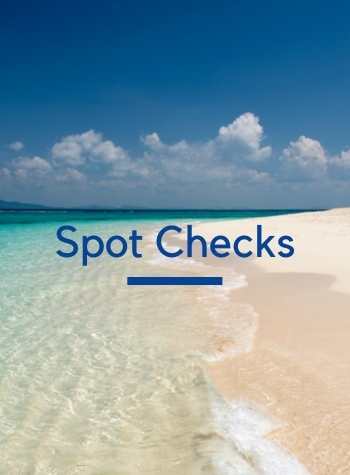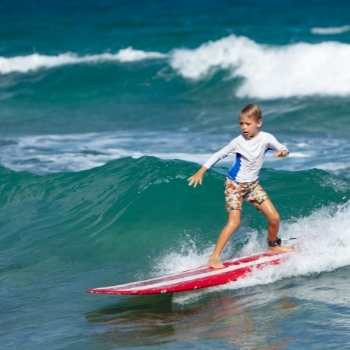If youʻve been surfing for a long time, youʻve probably seen a shark or had that spidey sense tingle down your spine letting you know that one might be lurking nearby. Sharks are real and they dominate wherever they go.
That doesnʻt mean that sharks should keep you out of the water. There are things you can do to keep you “safer” from sharks. Iʻve put together 8 tips that you can use to reduce your chances of ever meeting one in the first place.
So if the fear of sharks is keeping you from surfing, then you have to read on.
8 Tips for Surfers to Avoid a Shark Encounter
1. Choose The Right Surf Spot
Certain areas tend to be more sharkier than others. River mouths, storm drains, piers, fishing harbors and jetties are known shark hangouts. Unfortunately theyʻre often prime surf spots as well.
If you are really worried about sharks, try sticking to a wide open beachbreak or point break that does not have a river feeding into it. And stay away from Australia!!
2. Understand What Makes Sharks Tick
Knowing which species of wildlife live in the area that you want to surf at can play a big role in shark avoidance. If there is a population of sea lions, turtles or even fish spawning in that location then the chances of encountering a shark may be increased.
Where I live in Hawaii, sharks are known to coming into shallower waters every November to breed. You can see dozens of them in certain places.
So naturally, in Novemeber, certain spots get avoided or surfed during midday when sharks are less active. Being a keen observer of nature can help you guide a safe path, free from shark attract.
3. Pick The Correct Time and Conditions To Avoid Sharks
Sharks hunt normally at dusk, dawn and during the nighttime. Avoiding these times will reduce the chances of an attack.
Dark water and low lightning mean that a sharks’ vision is obstructed and they rely on their sight as one of their critical senses. Without good vision, a shark might attack something by mistake.
Murky water obstructs a shark’s great eyesight, this will make it harder for the shark to identify you correctly and for you to see the shark. Recent rainfall often causes the water to be murky so avoiding the ocean after a storm is recommended.
When in doubt, listen to your spidey sense. I donʻt get it often, but one day I found myself surfing perfect waves with 3 other guys at a fickle spot in Northern California. The waves were so fun, but then I got this feeling. We were not alone. I paddled in.
No one got attacked that day so the other guys who stayed scored, but sure enough there was a shark sighting at that same spot later in the day. I for one donʻt want to find out if theyʻre hungry.
4. Stay Closer To Shore and Stick With Others
It is recommended to avoid being the surfer who is the furthest out from the shore. Commonly there is a drop-off right after where the last sets are rolling in. Sometimes sharks like to hunt along this ledge and watch for activity on the surface.
Sharks are opportunistic and are more likely to target a single object rather than a group. By sticking with other surfers you will be safer in numbers.
To learn more about when you should and shouldnʻt surf alone, be sure to check out this post.
5. Move Regularly To Distract Sharks
When sitting on your board waiting for waves it is recommended to regularly turn your board in different directions. Sharks pay attention to where their prey may be looking and not looking.
By moving regularly you will be acting more like a predator. The shark will then not know where your blindside is and might not consider an ambush attack an option.
6. Avoid Certain Clothing
Wearing bright colors and anything shiny e.g jewelry can make you appear to look like prey to the shark. These items and colors can reflect light and become eye-catching to a shark.
Itʻs how fishermen attract fish to their hooks, so donʻt make yourself a lure for the sharks.
7. Utilize Shark Repellents
There are many different shark repellents on the market. From pepper-based wax for your surfboard to shark eye stickers for the bottom of your board. There are also bracelets called Sharkbanz that can be found on Amazon that emit an electro-magnetic pulse that disturbs the shark’s electro-receptors.
Some of these methods may be superstition more than anything, but if it has any chance of giving you a competitive chance, then why not?
8. Look For Signage
Before entering the water look for any warning signs that state if a shark has been spotted recently. Alternatively, you can ask a lifeguard or local if sharks are regularly spotted at that particular beach.
Thatʻs not to say theyʻre always accurate. There has been a “shark sighting” sign at my local surf spot for 2 years. Granted, itʻs a known spot for hammerhead sharks, but know one has ever reported being attacked by one.
How Likely Is A Shark Attack While Surfing?
The chances of being attacked or even seeing a shark while surfing greatly varies depending on where you are surfing and in what conditions.
However, each year there are approximately 10 deaths attributed to shark attacks worldwide. This is compared to roughly 150 deaths caused by falling coconuts. No one would normally consider a coconut to be more deadly than a shark however the statistics don’t lie.
Every year more people are killed by crocodiles, elephants, bees and from more mundane animals than sharks. If you use common sense and the tips that we detailed above your chances of even encountering a shark while surfing will be significantly reduced.
In fact, you can get yourself hurt surfing doing all sorts of things than the likelihood of a shark biting your arm off. You can learn about a few ways you can get hurt surfing in this post.
What To Do If You See A Shark?
If you do happen to see a shark while surfing, it is recommended to leave the water immediately. Try to stay as calm as humanly possible while paddling back to the shore.
If there are other surfers nearby shout loudly to warn them of what you have seen. It is not advised to antagonize or to try and scare the shark away.
It is recommended to not surf in that area for two days after the sighting as the shark might be searching for prey and may stay in that area to hunt.
Reasons To Not Be Afraid of Sharks
Humans are not a part of a shark’s diet because we are too bony. Sharks are picky eaters because they have a slow digestion process. Their ideal meals are animals that are high in fat such as seals, fish and whales.
Scientific data has revealed that 90% of shark attacks are mistaken identity. This is why shark attacks commonly consist of only one or two bites. The shark then swims off with a bad taste in its mouth. Sharks are similar to dogs in that they pick things up in their mouth to test what it is.
Out of the 360 species of sharks only four have caused unprovoked attacks on humans. These are the Great White Shark, Bull Shark, Tiger Shark and Oceanic Whitetip Shark. Making the majority of shark species harmless to humans.
Sharks have been given a bad image from movies such as Jaws and the media loving to cover shark incidents. However, the animal that kills the most humans every year is the mosquito. Sharks clearly need a new PR representative to clean up their image.



